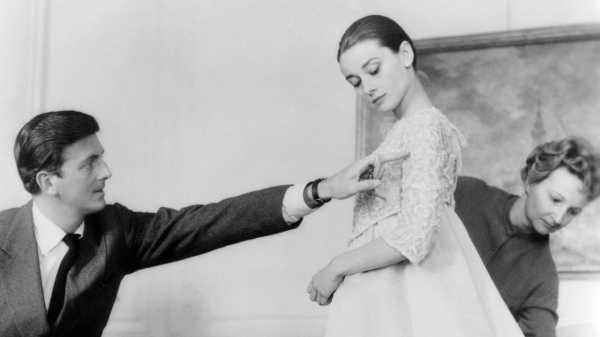
In April of 1952, at the age of twenty-five, Hubert de Givenchy arrived
at the Waldorf-Astoria Hotel, in New York, with eight elaborate couture
gowns. He was making his American début at the first annual April in
Paris Ball, a high-society spectacle that was meant to strengthen
Franco-American relations through the power of good old-fashioned
beau-monde hedonism. The event featured, among other attractions, zoo
animals rented from the Ringling Brothers circus; a living tableau in
which Sir Laurence Olivier and Rex Harrison played François I and Henry
VIII; a gift of fine French perfume for the women and neckties made in
Lyon for the men; and a cavernous ballroom transformed to resemble the
gardens at Versailles. And yet the most memorable impression of the
night was, perhaps, the one left behind by the six-foot-five wunderkind
couturier. During the fashion-show portion of the evening, the crowd
cooed over Givenchy’s meticulously embroidered boleros and a starched
white peplum cape that looked like stiff meringue.
Givenchy, who died on March 10th, at the age of ninety-one, was born in
Beauvais, France, the grandson of a tapestry-maker, and blazed through
teen-age apprenticeships at the houses of Jacques Fath, Robert Piguet,
and Elsa Schiaparelli before striking out on his own, in February of
1952. His vision was clear from the beginning: he was determined to give
women in the postwar era more plentiful options by designing
“separates”—couture tops and bottoms that could be mixed and matched at
will. The idea for a two-piece ball gown was, at the time, quite the
innovation. “By giving her the opportunity to make changes in her
costume,” one fashion reporter for the Times gushed after meeting
Givenchy, in 1952, “the designer feels that he is offering his client
the pleasure of feeling herself a bit of a creator of her own style.”
Still, in the summer of 1953, when the woman who would become his most
important client first walked into his atelier in Paris, neither was yet
a household name. As the well-worn anecdote goes, when Givenchy heard
that a movie actress with the surname Hepburn was due to pay him a
visit, he assumed that he would be meeting Katharine, and was confused
when a woman appeared at his door “with doe eyes and short hair and
wearing a pair of narrow pants, a little T-shirt, slippers, and a
gondolier’s hat with a red ribbon that said Venezia.” It was the
twenty-four-year-old Audrey Hepburn, fresh off the filming of “Roman
Holiday.” She had come to Paris, at the urging of the director Billy
Wilder, to purchase authentic French clothing for “Sabrina.” Givenchy
was charmed by her, but he was in the throes of preparations for his
fall presentation, so he told her that he had absolutely no time to
create anything new for her to wear. Hepburn begged to try on the
existing sample garments that were hanging around from a previous
season, and, in a mid-century spin on “Cinderella,” every seam fit the
slender actress perfectly. Givenchy was so delighted to see this giddy
actress bouncing around in a black cocktail dress, his signature boxy
neckline flattering her clavicle, that he dropped his work that evening
to take her out to a bistro.
For the next four decades, Hepburn wore Givenchy with near-religious
devotion. Most famously, she wore a Givenchy gown as she stood idly
munching on a pastry outside the Tiffany windows as Holly Golightly, a
scene that stopped traffic on Fifth Avenue as it was being filmed. Many
designers have a muse, but the Hepburn-Givenchy relationship was
something more entwined and symbiotic. The actress often called the
designer just to talk, and she told reporters that he was a
“psychiatrist” as well as a dressmaker. In Hepburn, Givenchy found an
ideal emissary for his theory of separates; she became known as a jaunty
pip in his clothes because she could move in them. Givenchy’s legacy is
the notion of “personal style,” a concept we now take for granted, but
one that was not baked into fashion in the same way before Hepburn and
the little black dress that helped make her a star. “He is far more than
a couturier,” Hepburn said of Givenchy. “He is a creator of
personality.”
Givenchy was as avid a businessman as he was a designer. In witnessing
Hepburn’s rise firsthand, he saw the limitless potential of brand
recognition. In the seventies, he launched a menswear line, officially
licensed his name, and became one of the first designers to put his
brand on more than just clothing—Givenchy silverware, china, hotel
draperies all eventually became available. The name “Givenchy” became
shorthand for bubbly, au-courant French chic with a dash of Old World
sophistication. After Givenchy’s retirement from designing, in 1995, the
house (which he sold to LVMH, in 1988) became a breeding ground for
young, avant-garde designers launching their careers—John Galliano,
Alexander McQueen, Julien Macdonald, and then, for twelve years,
Riccardo Tisci, who rebranded the house with ornately gothic gowns in
delicate oxblood and putty-colored gauze. (It is said that Tisci was the
only person who did not mention Hepburn in his interview, and this
radical omission clinched his job.)
Tisci left Givenchy in 2017, and now the house has its first woman at
the helm, Clare Waight Keller, a British whiz kid who, in the mold of
the house’s namesake, had done stints at Calvin Klein, Gucci, Pringle of
Scotland, and Chloé by the age of forty-one. In October, Keller
presented her first collection, after an hour-long meeting with the
ninety-year-old Givenchy. She told the press that she had pored over his
early sketches and found that he designed from the shoulder down, so she
had done the same. What emerged was a collection that returned to items
with square, sleek silhouettes—many of them separates—in winking homage
to Givenchy’s early work. Keller showed a navy double-breasted dress, a
black-and-white evening gown paired with cowboy boots, and a fluttery
cocktail dress the color of Red Hots with a neckline similar to the one
Hepburn wore in “Breakfast at Tiffany’s.” This sleek but youthful
collection débuted at the Palais de Justice, a grandiose building in the
center of Paris, where Marie Antoinette was imprisoned while awaiting
her execution. It had never been used for a fashion show before, but, as
in the case of the April in Paris Ball, the house of Givenchy has never
shied away from spectacle. The elder designer did not attend the show,
but Keller said later that she felt she had his blessing.
Sourse: newyorker.com






